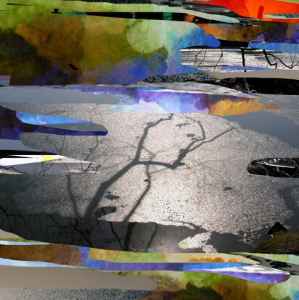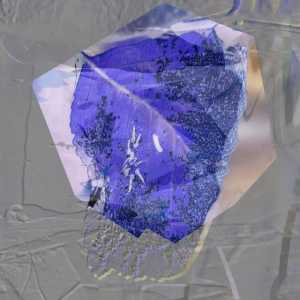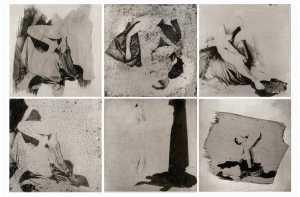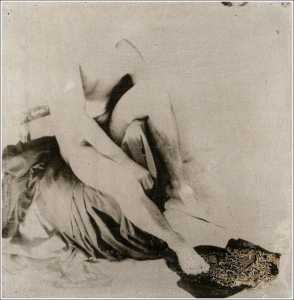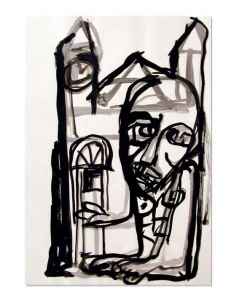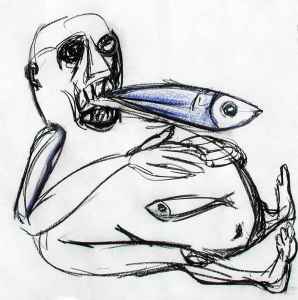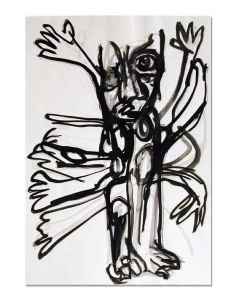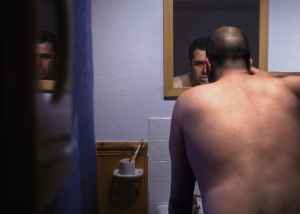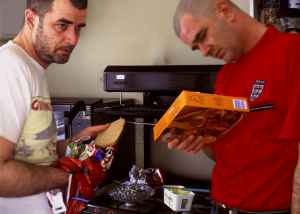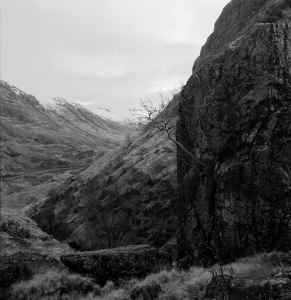poke around
special offers
art galleries
artist website
featured artists
editor´s choice
virtual collections
most wanted works
help / FAQ
terms and conditions
about artists24.net
my bookmarks
 deutsch
deutsch
 español
español francais
francais
 russkii
russkiiprivacy policy
press releases
imprint
| Featured Artists der artists24 Redaktion (more information) Weitere kuratierte Künstler finden Sie im Archiv. |
|
| Jaap de Vries from Netherlands *1959, lives and works in Breda, Netherlands Jaap de Vries creates in his watercolors disturbing scenes. In his recent work everything seems to be under water and nebulous, one can hardly identify bodies. Shapes dissolve, appear garbled. At the same time a morbid beauty characterizes the imagery of de Vries. A closer look reveals that his paintings can be read as statements about the world. For the apparently harmless motifs such as fish, landscapes, nudes, portraits of women or situations appear like "crime scenes". De Vries claims himself as a convinced anti-political artist. Nevertheless, he writes in a commentary, what makes politics for him: The way in which bodies are manipulated and trapped by fear. By putting vulnerable bodys in scene, he shows exactly those inconvenient aspects which are denied by a bigoted policy. Seen this way Jaap de Vries is certainly a highly political artist. Artist information More art by this artist Kuratiert/ Text: Dr. Stefanie Lucci |
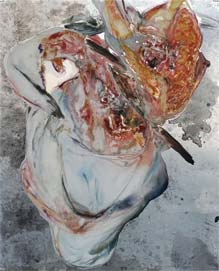 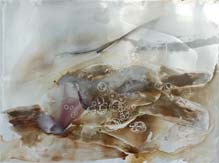 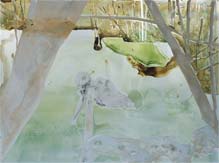 Artist information More art by this artist |
| Mario Reis from Germany *1955, lives and works in Düsseldorf, Germany It is fascinating how Mario Reis has transcripted the genre of landscape paintings into contemporary times. He uses the artistic forces of nature, to which he concedes great artistic freedom. Especially impressing are his „Naturaquarelle“ (Nature Water Colors) in which rivers and creeks portrait themself. For this Reis installs canvasses in selected watercourses and the respective river then in an elaborate method displays itself on the canvasses. In this procedure, depending on the character of the river, water colours come to existence which range from sensitive to dramatic abstract but still completely realistic representational paintings. These selfperpetuating selfportraits attract by their richness of colours ranging from yellow, orange, red, reen via brown to black. n bis hin schwarz reicht. Other series are his „Blindzeichnungen“, which Reis draws blindfolded, the „Zugspuren“ in which the deforming forces and tracks of real driving trains are converted aesthetically. A lot off humor lurks in his series with firecrackers in which he narratively incorporates the explosive power as in the title of one work which he called „And I thought you were a prince“ Artist information More art by this artist Kuratiert/ Text: Dr. Stefanie Lucci |
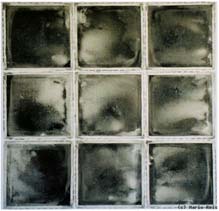   Artist information More art by this artist |
| Stefan Fransson
from Sweden *1955, lives and works in Stockholm, Sweden The artificial compositions of Stefan Fransson seem to be comprising more than only the known dimensions of time and space. They show a complexity beyond the ordinary optical experience. An undefined vastness pervades these picture-worlds which seem to be lying in an infinity barely comprehensible with our senses. It is impossible to identify a beginning and an ending. These are complex arrangements, in which Fransson composes endless layers of pictoral fragments like collages on top and underneath each other translucent diaphane-like. It’s almost as if these worlds would be weightless - floating. Some elements appear to be familiar, like flashes of memories, mingling with others. Other elements stay strange in their abstraction. In the light of these suggestive permeations of picure elements, Franssons worlds breach paradigms in which linear fabrics of cause and effect are represented. Much more in his compositions, natural scientific and philosophical questions in which associations of networking are a basic principle are hinted. By this Stefan Fransson seems to succeed in building bridges between art and science, because his worlds seem to implement these theories visually. Artist information More art by this artist Kuratiert/ Text: Dr. Stefanie Lucci |
|
| Franciso Navarrete Sitja
from Chile *1986, lives and works in Santiago de Chile, Chile In his fotographies Franciso Navarrete Sitja shifts between painting, drawing and digital images. He quotes classic compositions as well as the classic genres of self-portraits, nudes and motives of art history. Sitja, with his hand proofs on aluminum, insists on uniqueness when he uses emulsion like paint and / or pixels his paintings by hand - making a reproduction impossible although he mainly uses mechanic techniques. Over and over again he plumbs the borderlines beween different generas by visualising the shift of drawing and painting via fotography up to digital manufacturing techniques. at this he moves details into the foreground, fading image elements and lets the emulsion crumble as if it was aging paint. some details remind us of the known but without getting to precise. Sitjas fotographies change between showing and hiding, which accounts for the idiosyncratic appeal of his pictures. It seems as if they were remaining in poetic intermediate worlds.
|
|
| Marcus Günther
from Germany *1967, lives and works in Düsseldorf, Germany In Marcus G?thers paintings the known world seems to be off it's hinges. one absurdity follows the next. He acquaints us with almost surreal collages of the well known and nightmare-like cravings. Marcus G?her explains: "the fantastic misbelieve that a better world could be achieved by the intervention of a higher might gives us hope, that we seem to need. I am on a quest for reason which is lost in these days." So he looks for reason in the bomb-belts of suicide bombers, in the papal adjurations, rape-scenes and obese figures with disgustingly milky, bulb-like faces. over and over again we see erect penisses pointing to the sky. strange objects with decided life of their own are floating through the skies - they are "Sinnk?per" (reason-bodies) developed by Marcus G?ther that populate and pervade G?thers pictorial worlds. These artificial organisms remind us of flying arses that seem to spread more and more in his worlds. a statement to our world could not be more characteristic.
|
|
| Alexandre G. Vilas Boas
from Great Britain *1973, lives and works in Guarulhos, Brasilien In his virile drawings Alexandre Gomes Vilas Boas deals convincingly crtitcal with the catholic orthodox church. We see biblical scenes drawn with an astonishing expressive stroke wich are converted into new meanings. For example as in the black and white drawing Luoco da Matriz II, where one could get the impression of Jesus Christ riding on a donkey into Jerusalem. The title „The madman of Matriz“ refers clearly to the bigges and most important catholic church in Uruguay, in which the founder of the state Artigas was baptised. A further drawing is named „souls to let“ and we see a man in whos body we see multipal souls. In another drawing we see a fat man disgorging a fish. This scene instantly reminds one of the first followers of jesus the apostles who were fishermen from the lake Genezareth and who he turned into fishers of men. There is yet another relation. The drawing also relates to the story of Jona from the old testament. Three days and nights the disobedient prophete had to spend in the whales belly until he was cast back ashore. The fish is also an allegory for Jesus himself (in ancient Greek: ichthys equals fish and also Theos / god, Uios / son, Soter / redeemer) and refers to not only the last supper but also to Jesus who fed the five thousand with bred and fish. Zynically Vilas Boas titles this drawing with Experts and places it clearly into a actual political context. |
|
| Cameron Jinks from Great Britain *1963, lives and works in Great Britain In his series ?work in progress? Cameron James makes fun of the typical mens world. He has managed to place every possible preconception and cruel platutitude in the "scene". The title of the series alone is symptomaic for this matter. Spanning from looking into the mirror, watching porn, cleaning, the secrets of a microwave, handcrafting, altercation,to watching soccer or the late-night dialogue with the whisky bottle. Artist information More art by this artist Kuratiert/ Text: Dr. Stefanie Lucci |
|
Weitere kuratierte Künstler finden Sie im Archiv.
|
|
|
Featured Artists of the editors of artists.de
|
|

